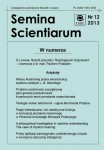Próby aplikacji paradygmatu ucieleśnionego umysłu w tworzeniu sztucznej inteligencji
DOI:
https://doi.org/10.15633/ss.579Słowa kluczowe:
artificial intelligence, embodied mind, Andy Clark, Roodney Brooks, Maya Matarić, Cog, biotsAbstrakt
Despite some significant achievements in the early stage of works on the development of artificial intelligence, scientists failed to program machines to imitate human thinking. The next generation of scientists included proposals of the embodied mind paradigm in their new research programme. The paradigm states that human intelligence is formed through a reciprocal interaction between the body and an environment. This work discusses the application of the main proposals of the new artificial intelligence that were applied in the process of constructing machines and modelling their behaviour. It presents important projects that met the philosophical criteria and that were aimed at embodying artificial intelligence.
Bibliografia
Clark A., Where brain, body and world collide, “Daedalus: Journal of the American Academy of Arts and Sciences”, 1998, 2, s. 257–280.
Feil-Seifer D., Matarić M., Distance-based computational models for facilitating robot interaction with children, “Journal of Human-Robot Interaction”, 2012, 1, s. 55–77.
Komosiński M., Sztuczne życie. Algorytmy inspirowane biologicznie, „Nauka”, 2008, 4, s. 7–21.
Lakoff G. P., Johnson M., Co kognitywizm wnosi do filozofii, „Znak”, 1999, nr 11, s. 25–32.
Lakoff G. P., Johnson M., Metafory w naszym życiu, Warszawa 2010.
Merleau-Ponty M., Fenomenologia percepcji, Warszawa 2001.
Moravec H., Mind children. The future of robot and human intelligence, Harvard 1988.
Brooks R. A., Stein L. A., Building brains for bodies, http://groups.csail.mit.edu/lbr/hrg/1993/AIM-1439.pdf (28.01.2013).
Scassellati B., Admoni H., Matarić M., Robots for Use in Autism Research, 29.01.2013,<http://www.annualreviews.org/doi/pdf/10.1146/annurev-bioeng-071811-150036>.
Werner G. M., Dyer M. G., Evolution of Herding Behavior in Artificial Animals, [w:] From Animals to Animats 2: Proceedings of the Second International Conference on Simulation of Adaptive Behavior, Meyer J.-A., Roitblat H. L., Wilson S. (red.), Camridge 1993.
Wilson M., Six Views of Embodied Cognition, http://www.indiana.edu/~cogdev/labwork/WilsonSixViewsofEmbodiedCog.pdf (26.01.2013).
Pobrania
Opublikowane
Numer
Dział
Licencja
Prawa autorskie (c) 2013 Anna Sarosiek

Praca jest udostępniana na licencji Creative Commons Attribution-NonCommercial-NoDerivatives 3.0 Unported License.
Twórca oświadcza, że przysługują mu prawa autorskie do utworu i że nie są ograniczone w zakresie objętym niniejszym oświadczeniem oraz że utwór jest dziełem oryginalnym i nie narusza praw autorskich innych osób.
Twórca zezwala Uniwersytetowi Papieskiemu Jana Pawła II w Krakowie na nieodpłatne, niewyłączne i nieograniczone w czasie korzystanie z utworu, to jest:
- utrwalanie i zwielokrotnianie: wytwarzanie egzemplarzy utworu techniką drukarską, reprograficzną, zapisu magnetycznego oraz techniką cyfrową;
- obrotu oryginałem albo egzemplarzami, na których utwór utrwalono (wprowadzanie do obrotu, użyczenie lub najem oryginału albo egzemplarzy, publiczne wystawienie, wyświetlenie, a także publiczne udostępnianie utworu w taki sposób, aby każdy mógł mieć do niego dostęp w miejscu i w czasie przez siebie wybranym);
- włączenie utworu w skład utworu zbiorowego;
- udzielanie przez Uniwersytet Papieski Jana Pawła II w Krakowie sublicencji Creative Commons Uznanie autorstwa-Użycie niekomercyjne-Bez utworów zależnych 3.0 Polska
Uniwersytet Papieski Jana Pawła II w Krakowie udostępnia utwór na Platformie Czasopism należącej do uczelni, na licencji Creative Commons Uznanie autorstwa-Użycie niekomercyjne-Bez utworów zależnych 3.0 Polska. Tym samym uprawnia wszystkich zainteresowanych do korzystania z utworu pod następującymi warunkami:
- zostanie podany autor i tytuł utworu,
- zostanie podane miejsce publikacji (tytuł czasopisma i adres internetowy do oryginalnie opublikowanego utworu),
- utwór będzie dystrybuowany w sposób niekomercyjny,
- nie będą tworzone utwory zależne.

